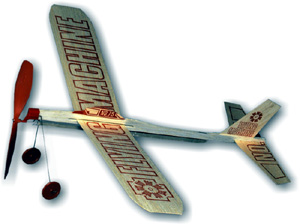Low-tech balsa wood gliders endure

You probably have to be at least 50 to remember balsa wood gliders.
For 75 years, Paul K. Guillow, Inc. has been cranking out balsa wood gliders you can put together in seconds and fly. Throw it and it flies - the video below shows a good toss which doesn't produce much more than five seconds of flight. The absence of batteries or electronics is sure to vex 30-somethings and today's kids, but the gliders are smart for their simplicity and aviation basics.
What's more, there's no environmental impact from operation or disposal. Lightweight and porous, balsa wood comes from South and Central America so I am unsure as to whether any rain forest is sacrificed in the gathering of raw materials. Some is plantation grown.
About as sophisticated as the gliders get are the rubber bands drive which I recall overwinding and breaking. But those gliders or more accurately, airplanes, would fly for 15 seconds or so especially when launched from up in a tree (tree climbing is another low tech pasttime for kids...). It taught us how the Wright Brothers felt - that a few seconds of flight can be thrilling.

The Wakefield, Mass. company was started by WWI Navy aviator Paul K. Guillow in 1926 as Nu Craft Toys - a full year before Lindbergh fired the national imagination with his daring trans-Atlantic crossing flight in the Spirit of St. Louis. Guillow is still going.
Balsa wood gliders used cost a 10-25 cents apiece, but today start at $1.50 and go up to several dollars. Guillow also makes both un-powered and powered remote control planes from plastic foam that cost as much as $70. And it makes dozens of balsa wood model planes for display ranging between $25 and $45. Remember, many early planes were similarly constructed from wood and canvas.
Who buys balsa wood gliders? Certainly, my kids of Wii generation (now 22 and 20) wouldn't. It's a nostalgia purchase: since 1999, Guillow's web site has enjoyed more than 13 million visits.
"It's more an attraction to the adult who buys it for the kids. They remember it from their childhood. They can just take it out of the bag, put it together and throw it. It's just fun for kids," Guillow president Thomas G. Barker was quoted as saying in a recent profile of the company in the Boston Globe.
You used to be able to buy the gliders in the corner market, but they are largely sold now in hobby shops or at least that's the case with pricier display models. The next time I go to a 7-11 or CVS, I'll check to see if they carry the gliders. I suspect not.
By today's standards with electronics bumping up against reality, tossing a balsa wood glider seems like a cheap thrill. There's not much more to it than a paper airplane. But it's cheap thrill and memory I treasure.
Follow me on Twitter.
This post was originally published on Smartplanet.com